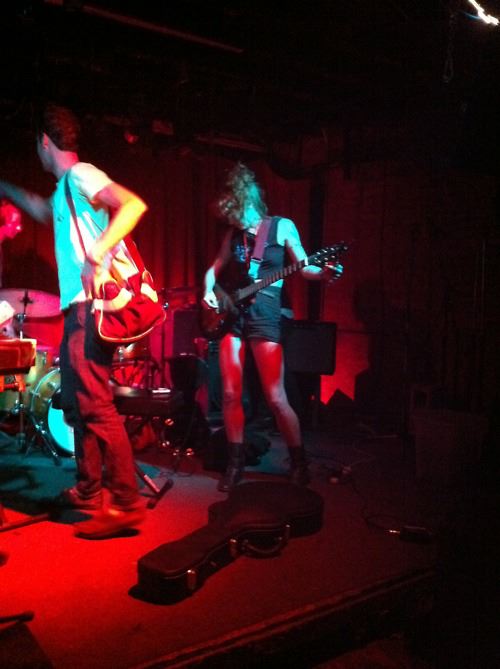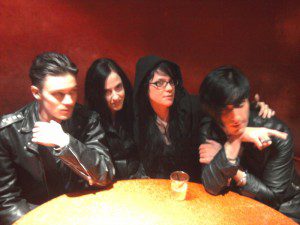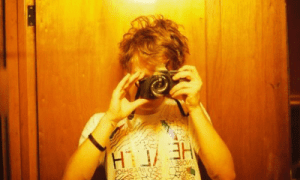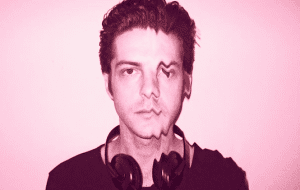
Please join us Thursday, 1/16 at Spike Hill for our second anniversary showcase. This year has been a shit show for us, and we’ve made exciting strides, creatively, professionally and personally through our evolving project here at Audiofemme. We’ve gone from two waitresses, complaining over tequila about the glass ceiling that envelopes the oh-so-insular music writing/new media industry, to two waitresses plus one web femme, blogging in cafes about the cool new band we caught the night before at a warehouse party in Bushwick, to two editors, sitting in our sunny offices with our crazy talented writing team, plotting our next steps forward and what we want to order for lunch.
For AF’s bday party, we’re bringing you an insanely good line up of live music, followed by what we hope will be a raucous dance party. Please find a few of our artist profiles below (more to come), and all the deets regarding set times/venue specs can be found on our events page here: https://www.facebook.com/events/1411538842420080/.
We hope to see your pretty faces this Thursday at Spike Hill.
xoxo
AF
Crooked Tails
Brooklyn-based city slickers Crooked Tails channel a bygone era with their floor-thumping, string-
heavy Americana. With the ghosts of Johnny Cash and Patsy Cline hanging on their shoulders, dual vocalists Jeffrey and Shana bring a sweet singalong-ability to the project, augmented by a wide range of instruments, seamlessly blending traditional old-time instruments with drums and electric guitar. Shana’s delicate soprano lends these songs a haunting quality that’s not easily forgotten.
Audiofemme: Where did you all grow up, and what did you grow up listening to?
Crooked Tails: Jeff: Dave(drums) and I grew up in Connecticut, but I was closer to Hartford and he was closer to Bridgeport. Ricardo(bassist) is from Valladolid Spain.
Shana: I grew up in a small town in Florida called Deland and Alex(lead guitar) grew up in South Florida
Jeff: The first band I ever fell in love with, which are still my favorite, was Nirvana and Ricardo is similar. From them I began getting into punk and hardcore and played that style for many years, and Dave did as well. Ricardo loved all the post punk stuff, the Pixies, Sonic Youth, Joy Division.. It was later on that we would get into the folk/alt country sound.
Shana: I listend to quite a variety growing up thanks to my family. Everything from Metal to Disco to Rockabilly to Southern Rock. Though through my teenage years it was always about the blues, early country like Johnny Cash and The Everly Brothers, and punk music. Alex grew up listening to a lot of delta blues, golden oldies, and 60’s/70’s english rock.
AF: Your drummer, Dave, walked in to audition for Crooked Tails thinking he was trying out for a Black Metal band. What’s it like incorporating different influences into what’s typically a traditional genre? Do you ever throw some of Dave’s metal background into the mix?
CT: Jeff: Well Dave knew who I was through the punk/hardcore/metal scene in CT so he came in expecting it to be something different. BUT, his favorite bands are Behemoth and Bon Iver, so he is pretty diverse. On some of the newer songs he incorporates some harder hitting drums and an edginess that I think will always be present in people’s playing that came out of those scenes.
AF: Your name makes for a striking, and kind of dark, image, and turns up in the lyrics to “Broken Tails.” How’d you settle on calling yourselves Crooked Tails?
CT: Shana: Well…because everything else was taken. hahahah. But really, we had just finished writing Broken Trails and still didn’t have a name. So Jeff and I are practicing the song one day and were like I wonder if Crooked Tales is a band, which it wasn’t! So to kind of somewhat break it away from the song we switched it to “Tails” instead of “Tales”.
AF: If you could record a song with any band or musician, living or dead, who would it be? What song would it be?
CT: Jeff: Song…I’m not sure, but an artist, though unfortunately dead, that I think I could learn a lot from is Townes Van Zandt.
Shana: Ah shit always a hard question…I always say this though, I would love to work with Jack White. Every project he’s worked on is a favorite of mine. And his recent collaboration with Wanda Jackson made my ears so happy! On the deceased side though I would of loved to work with Waylon Jennings or Patsy Cline.
5. We’re curious about your songwriting process. The music on your demo seems to flow organically from image to image, even morphing into “Hit The Road Jack” at the end of “Broken Tails.” Who writes your songs and lyrics? Is it collaborative?
CT: Jeff: Some songs Shana writes the lyrics and melodies and then I’ll add guitar, and then other songs I will write the lyrics and music to. Once we have the basic ideas, we bring the other guys in to add in their parts and give them life.
I should also add that the demo isn’t something we are all too proud of… we did it early on just to have something rough to get shows and show the other guys. So, some of the band didn’t even play on it. We go in to record a 6 song EP Jan. 18th, and we will sound much better now that we’ve been playing together for a while.
Take a listen to Crooked Tails’ “The Devil Came Thru”, off their recent demo, here:
XNY
The stripped-down rock duo XNY’s spotlights Pam Autuori’s gorgeous powerhouse voice and Jacob Schreiber on the drums. Their second and most recent release, Orange, brings an enormous sound from just two musicians. The result of the pairing is catchy, magnetic rock and roll that revels in its simplicity.
Audiofemme: The two of you met after you shared a wall in an apartment building, hence the title of your first record, Through The Wall. After you met, was the chemistry instantaneous? When did you start playing together?
XNY: Our initial meeting involved cheesecake and a lot of wine–ingredients for instant chemistry. We decided to play together as soon as my nap time started coinciding with Jacob’s practice time. Surprisingly, all of the disturbances worked themselves out nicely…
AF: What are your musical backgrounds? What kinds of things did you play before you started playing together?
XNY: My dad plays guitar, I grew up listening to him cover Springsteen and The Beatles, I asked him to teach me guitar when I was eight and began writing my teen angst pop songs shortly after that. I covered a lot of 90s rock/grunge and A LOT of cheeky pop songs, “Kiss Me” was a regular at open mics… Jacob was in a heavy metal band in his angsty years, and then matured into jazz…and then immatured into rock.
AF: What was your vision for Orange, going into making that album? Did anything about how it turned out surprise you?
XNY: Our goal was to capture our live sound. It was a great experience working with Brian Viglione at Stratosphere Sound (which has since closed). We experimented a lot with electric guitars, bass, organ etc. Recording Orange really helped us develop our sound and open our minds. We used to avoid any electric instrumentation, I have been playing acoustic guitar for years, and I will gladly admit I am having a serious love affair with my telecaster.
AF: Your music has this fun, no-nonsense energy that translates so well into live performance. How do you feel about playing shows?
XNY: Thank you! We love playing live, that is where we feel most comfortable. It’s like therapy… really loud therapy.
AF: If you were to go on your dream tour with any band or musician of your choosing, living or dead, what would the lineup be?
XNY: Ooo this is a tough one! I would love to go on tour with The Rolling Stones circa 1971… I’d also throw in some Janis and a little Etta James… And why not some Jack White while we’re at it… And Beyonce. Always Beyonce. This is turning into a bizarre show…
Listen to XNY’s “Who Are You”, here:
Daytona
Though they’ve been friends for years, Daytona only solidified as a band after its three members relocated to New York City from Chapel Hill, North Carolina. Each of the trio boasts a solid garage rock background, but in combination, the group is something more complex: their full-length debut is brimming with high-energy, complicated indie pop, meandering guitars and gorgeous vocal harmonies. Though Daytona’s warmest, most ethereal moments, live up to their name, there’s something deeply nostalgic—sad, even—at the core of the music.

Foxes In Fiction
Foxes In Fiction is the musical vehicle of songwriter Warren Hildebrand, who writes and produces ambient and loop-friendly experimental pop. Foxes In Fiction uses lightly doctored guitar riffs to create an immersive soundscape that focuses on music listening as an almost visual experience. 2010’s Swing From The Branches, Foxes In Fiction’s full length debut, dwells in ambient drone loops for almost its full first half, but rather than obscuring the music, this experimental layering effectively laying groundwork for a hypnotic and sensorily magnified listening experience.
Audiofemme: Your first album was released as a cassette, and you co-run a cassette recording label. What’s the source of your interest in cassette recording?
Foxes In Fiction: I started Orchid Tapes while still living in Toronto in early 2010, but for the past year or so I’ve run it with my boyfriend our of our place in Brooklyn. From the beginning I wanted to release things on tape because of how easy it was to disseminate music on that medium (cheap to produce, easy and affordable to ship) and I liked that something like tapes stood as a direct antithesis to the mp3 / blog culture that was in full-swing in 2010; instead of endlessly digesting one song after another and never really feeling like I was forming a connection with a lot of the music I was coming across, listening to something on tape forced me to have a tactile relationship with it. There’s no option to skip through tracks and you have to flip it over once one side plays out. It’s basically all the same reasons that people have for liking vinyl, but of course they only cost a fraction of the price to produce which made it easy for smaller labels and musicians like myself to put them out.
AF: What’s the music scene like in Canada? Are there other musicians making music that’s similarly experimental to yours?
FIF: Canada’s a pretty massive country, and there are lots different scenes and pockets of people doing intensely creative, inspiring and experimental stuff in pretty much every part of it. Canada is great, I’ll always believe in it. I’m from Toronto, and there’s a lot of pretty fantastic music stuff happening there at any given point, and while I lived there I was fortunate enough to fall into a few different groups of people who approached music with a similar mindset to my own. I only lived there for about three years but I miss it and the people there a lot.
AF: Your songs are so visually evocative. Do you have imagery in mind when you start writing?
FIF: Maybe with the more ambient and old moody drone tracks on the first record I did; I would have particular images in mind or I would use a specific visual cue as jumping off point for a song. But with most of the recent ‘pop’ things I’ve been doing, the images I’m going for are more encoded in the actual lyrics than the music itself.
AF: How do your songs translate into live performance? Do you take a different approach to playing a show than you do when you’re recording?
FIF: Since I perform by myself, there is a certain Sweet Spot that I have to try and hit in between a) making it not boring for myself and b) making it not boring for the people watching. This can be kind of challenge because of the fact I use samples and pre-recorded material which I think makes a lot of people roll their eyes, but I try to not make a secret of it and do as much live instrumentation in between everything using my voice, keyboards and guitar with looping pedals and various effect pedals. There’s always a little process of de/reconstruction between the recorded version and the versions that I play live, which usually ends up making everything sound super loud and bass heavy, mostly because I’m pretty nervous when I perform and I wanna be able to hide away behind a huge wall of sound, ha ha.
AF: Earlier this year, you released a collaboration with Benoit Pioulard. What was that process like? What do you like most about collaborations?
FIF: It was awesome. He’s one of my top 5 most favourite musicians of all time and just an all-around amazing person, so getting the chance to work with him was really inspiring. All we really did was talk through some ideas the first time that we met while driving from Toronto to Montreal together, and then the rest was done by passing files back and forth to eachother over Gmail. The way the kids do it these days. Also, this is something I’m still kind of freaking out about, but I recently had chance to collaborate with Owen Pallett, another musician responsible for a massive amount of musical influence in my life. He wrote and recorded the string arrangements for my new record which elevated everything to this ridiculously amazing new level that I didn’t think was even possible for my music. I don’t even care about the songs themselves anymore, I just want the record to come out so people can hear his work.
Listen to Foxes In Fiction’s “Snow Angels”, here:
Prism House
Electronic duo Prism House are meant to be seen live, not only because a speaker system won’t dojustice to the intricacies of Brian Wenner’s thumping rhythms, echoing synth jumps and jumbled clips of barely understandable human vocals: half the group’s effect, orchestrated by Matt O’Hara, is live visual effect. Though it’s spacey and immersing, Prism House is too complex to be straightforward dance music. Instead, the constantly changing, multifaceted instrumentation form a soundscape that keeps revealing new layers as it progresses.
My first memory of beginning to play music was receiving a cheap electric guitar/amp combo and playing that thing for hours. The guitar was my passion for several years and I learned everything I know about melodic composition from the guitar. I only recently really started thinking of myself as a “composer” and not just a guitar player interested in electronics. I haven’t picked up the guitar in a while but it was a very formative instrument for me and helped the transition to making electronic music easy and fluid.
PH: Brian: The format and line-up of the group was fairly different back in 2011. Matt, who does our visuals exclusively for the group, was at the time making vocal drone music and our friend Pia was doing visuals. The group was a bit more primal and raw sounding in its initial stage and was meant to be solely a live experience.
When I joined the group Matt moved over to doing visuals and I handled the music. It wasn’t something we ever talked about but rather it happened naturally. My only goal was to create a performance group that truly is audio/visual. When you come to the show it is apparent that we are working together as opposed to just some visuals thrown in the background of a guy with a laptop. Another goal was to personally expand my compositional skills and focus on field recordings and audio collage aesthetics as opposed to synth based music.
Prism House has remained consistent to the overall vision I just talked about but I think we are both eager to expand the show in new and exciting ways. We’ve also talked about creating a theatrical production that incorporates our styles. Matt comes from a theatre background so we draw inspiration from that area with what we do.
AF: Do you think the process of songwriting and making music is different for a duo than it would be for a larger band? Does one of you take the lead on any given song or passage, or is the process collaborative?
PH: Brian: The process is absolutely different. I actually write all of the music for the group currently, and Matt creates all of the visuals. So in a way it’s collaborative in that we perform together, but we are both our own unique entities working independently. I love that relationship because it forces us to find a common ground in what we both do. We don’t actively sit down together and work on things because the process is very personal and insular for each of us. We tend to talk more about whether what we have created has a common thread that will translate well to an audience or viewer. Thankfully, it often works out so we don’t have to scrap much material.
I came from the background of writing and collaborating in a band setting and there is something exciting and unique about the group (band) mentality, but that way of writing doesn’t really work for this duo. Matt and I have different skill sets so it’s difficult for me to interject certain ideas into his work and vice/versa. Sometimes I miss the excitement of coming up with ideas as a group, but I find it really fulfilling and satisfying to work as a solo musician currently. There are pros and cons to each approach but at this stage in my life it makes sense to be writing as a solo artist and work in collaboration with Matt. Logistically, it is also much easier to be a solo electronic outfit than a full band when gigging in NYC so there is also that benefit.
AF: Matt, how did you begin focusing your visuals towards music? How do you translate sound into aesthetics?
PH: Matt: I worked in theatre for a long time making sound and music for plays. I think years of doing this must have trained my brain to expect a visual complement to everything I hear. Making visuals for music is the same thing as sound design, only in reverse. Brian’s music is great because it’s so dense and moves so quickly. When you come to a Prism House show, you are seeing a rough version of what I am seeing inside my own head.
AF: Prism House’s sound incorporates elements of dance music, as well as farther-out experimental stuff. What’s your philosophy about meshing the two? Who are some of your influences, as far as bringing the two styles together?
PH: Brian: My philosophy for incorporating dance and experimental elements in the music stems from having a vast appreciation of both genres and a natural combining of the two. On the “Reflections EP” I wasn’t actively trying to make an avant dance record but I found myself being extremely drawn to kinetic dance rhythms layered with field recordings and internet sampled material. The record started to take shape quickly once I had the general sound palette and tone figured out and the result was something cohesive and exciting.
I’m mostly inspired by my surroundings and NYC has been hugely influential on the sound of the music. I use a field recorder and sample sounds from all around the city and use those as the framework of the compositions. The tone and pace of the record feels very New York to me as well. I wouldn’t have made the record I did if I was still living in Ohio. I am also really interested and inspired by the idea of audio scrapbooking, or recording sounds for the sake of remembering certain moments in life. The EP is full of unique sounds that are very much a part of my NYC experience.
I don’t draw tons of inspiration from other artists, but I do really like Oneohtrix Point Never and Slava lately. I’m also just a huge fan of the RVNG Intl. label and Ghostly Intl. as well. There are so many cool and talented artists in Brooklyn today that it’s hard to keep up. The scene feels both vast but tight-knit and it’s exciting to be a part of something like that.
Listen to Prism House’s “My Love”, here:











